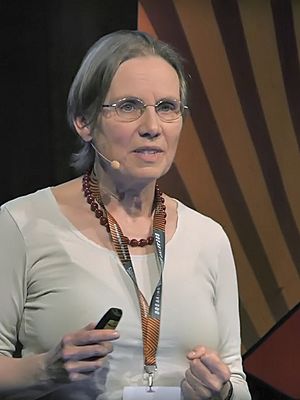Julia Yeomans facts for kids
Quick facts for kids
Julia Yeomans
|
|
|---|---|

Yeomans in 2018
|
|
| Born |
Julia Mary Yeomans
15 October 1954 |
| Alma mater | University of Oxford (BA, DPhil) |
| Spouse(s) | |
| Scientific career | |
| Fields |
|
| Institutions | |
| Thesis | Critical phenomena in disordered systems (1979) |
| Doctoral advisor | Robin Stinchcombe |
Julia Mary Yeomans is a British theoretical physicist. This means she uses math and computer models to understand how things work in the physical world. She studies "soft matter" and "biological physics." Soft matter includes things like liquids, gels, and foams. Biological physics looks at how physics applies to living things. Since 2002, she has been a professor of Physics at the University of Oxford.
Contents
Early Life and Education
Julia Yeomans was born on October 15, 1954, in Derby, England. She went to the University of Oxford for her university studies. She earned her first degree there. Later, she continued her studies at Oxford and received a Doctor of Philosophy (DPhil) degree in 1979. Her research focused on how materials change their properties at certain points, like when water turns into ice.
Research and Career in Physics
After finishing her DPhil, Julia Yeomans worked as a researcher at Cornell University for two years. In 1981, she became a lecturer at the University of Southampton. A few years later, in 1983, she moved back to the University of Oxford. She became a full professor there in 2002.
What Julia Yeomans Studies
Professor Yeomans works at the Rudolf Peierls Centre for Theoretical Physics. Her research involves creating computer models to understand complex fluids. These are liquids that behave in unusual ways.
She studies many interesting things, such as:
- Liquid crystals: These are materials that flow like liquids but have some order like solid crystals. They are used in LCD screens.
- Drops on surfaces: She looks at how liquid drops behave on surfaces that repel water, like a raincoat.
- Microchannels: These are tiny channels, often found in microchips, where liquids flow.
- Bacteria: She also studies how tiny bacteria move and interact in liquids.
In 2009, her research was shown to the public at the Royal Society summer science exhibition. It was called Nature's Raincoats: Bio-inspired surface science. This showed how nature inspires new materials.
Awards and Recognitions
Julia Yeomans has received many important awards for her work. In 2012, she received a special grant from the European Research Council. This grant helped her research how tiny amounts of liquid flow in complex environments.
In 2013, she was chosen as a Fellow of the Royal Society (FRS). This is a very high honor for scientists in the UK. Her nomination recognized her for developing new ways to study complex fluids. She combines her knowledge of statistical physics with powerful computers. Her work covers how tiny particles come together and how liquids flow. She also studies how bacteria move in liquids.
In 2021, she received the Sam Edwards Medal and Prize from the Institute of Physics. This award recognized her important contributions to the study of soft matter, active matter, and biophysics. In 2024, she was awarded the Liquid Matter Prize from the European Physical Society.
In the 2024 New Year Honours, Julia Yeomans was made an Officer of the Order of the British Empire (OBE). This award was for her great contributions to the field of physics.
Personal Life
Julia Yeomans is married to Peter Hore, who is also a professor. They got married in 1990.

